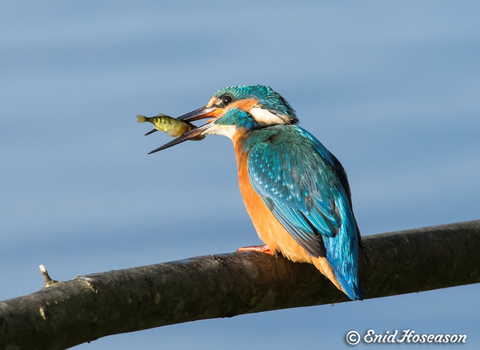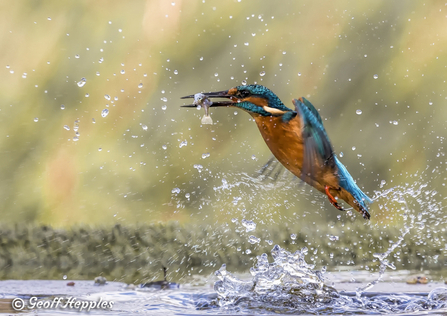
Kingfisher (c) Enid Hoseason
Kingfisher
The kingfisher Alcedo atthis, also known as the Eurasian kingfisher or the river kingfisher, is distributed across the globe from the UK east to India, China and Indonesia and north into Russia and Siberia and South to Northern Africa. Throughout its range there are seven subspecies with A.a. ispida found here in the UK.
The kingfisher must be one of our most colourful birds, it always flies fast and direct when traveling leaving a flash of blue engraved on the eyes of the observer. It's a small bird, about the size of a sparrow, but it leaves a big impression. The kingfisher doesn’t have a song but it does have a distinctive high pitched flight call and whistle. Listen here.
Kingfisher are quite sedentary birds only moving from cold regions where ponds and rivers freeze south into warmer and more coastal areas in winter. In the UK many birds nesting in Scotland move south for the winter. Birds begin disputing territories, which are around 1-3 km in length, from mid september, forming pairs from February when they merge territories with their mates. They are very territorial birds as they need to eat around 60% of their body weight in small fish and aquatic invertebrates daily and so fiercely guard their feeding sites.

Kingfisher (c) Geoff Hepples
Kingfishers excavate their nest holes in soft vertical river banks. The holes lead straight back for 60-90 cm with a slight incline and dips down at the back to create a hollow where eggs will be safe. The entrance is about 6cm wide, only slightly wider than the bird. They lay up to 10 eggs a time and generally have 2-3 broods. This large number of offspring helps to compensate for a high mortality rate in the young. Fledglings often become waterlogged and drown after their first dive. In addition to a high mortality rate in young birds, severe winters are also known to kill up to 90% of a kingfisher population as they are unable to fish when waters are frozen.
Severe winters are not as common as they once were in the UK but another threat to this species is poor water quality. The kingfisher is listed as an amber list species (one with a 25-50% decline) due to its population decline up to the 1980’s attributed largely to poor water quality along many UK waterways. Since the 1980’s water quality has improved and kingfisher populations are increasing, though annual fluctuations are often seen. The presence of kingfisher is a great indicator of clean waterways and a healthy river ecosystem so we are always happy to see kingfisher here at low barns for the sheer joy of the encounter but also what they tell us about the environment.
